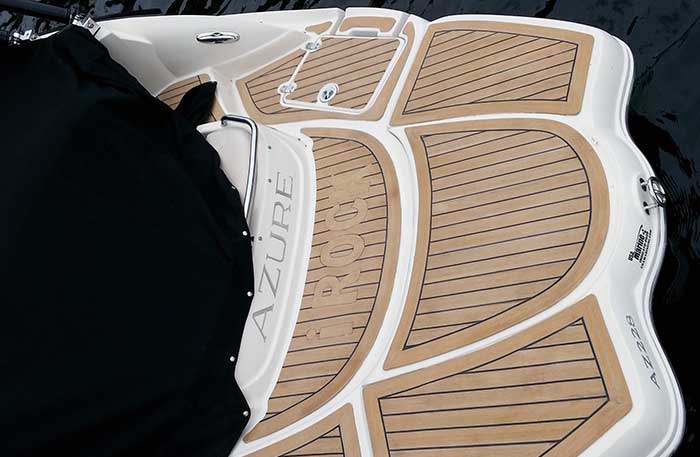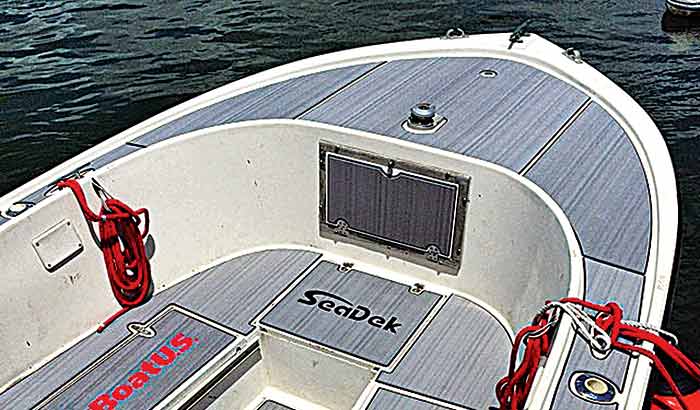Advertisement
Attractive, nonskid alternatives to teak decking have come a long way.

More and more boatbuilders are turning to PVC "teak" in place of the real thing, such as the NuTeak on the swim platform of this Azure.
Although many boaters might not think of it this way, a boat's deck is a critical piece of safety gear. Its job? To keep your feet, and therefore you, firmly planted onboard. Traditionally, decking achieved the necessary nonskid properties in one of three ways: being coated with textured paint; molded with aggressive patterns in the deck, or covered with teak wood, affixed to the deck with screws and glue.
Each of these presents drawbacks. Diamond-cut-patterned, nonskid, and textured deck paint tend to capture dirt and grime and can be difficult to keep looking clean. The "nonskid" particles in the paint can wear off over time making it ineffective. Teak, the best looking and most traditional of the three, requires maintenance, especially as it ages.
But there are alternatives, and they come, like so many other things in boating, in the form of acronyms: PVC and EVA. You're probably familiar with PVC (polyvinyl chloride), which is used in everything from pipes to window frames in the housing industry. EVA stands for ethylene vinyl acetate, closed-cell foam commonly found in flip-flops. If you've owned a pair of Crocs, you've enjoyed the comfort of EVA underfoot. Neither of these would have been considered suitable for marine decking without the addition of UV stabilizers to prevent it from becoming brittle and cracking. Choosing between these chemistries comes down to how you use your boat, and personal preference.
Tip
Faux Teak
The PVC version of teak comes formed in long rolls of narrow strips. Most manufacturers have designed a "tongue-and-groove" system to make interlocking the strips easy. The patterns that cover your deck are made from interlocking strips cut to length, joined together, and then bound by a border, if you like, to finish the look. You can do this yourself, but it's far easier to have these panels built by an expert at the factory. All you need to provide is a template. Or you can have an installer come to your boat and make the templates for you, and the final install. This increases the cost, of course, but should result in the best possible appearance.
Color combinations and styles vary by brand, which includes PlasDECK, Flexiteek, NuTeak, and Dek-King, among others. Professional installers may not be available in your area for all brands, and the warranty periods vary from five to 20 years, so it pays to shop around. In addition to selecting a color and style, you should look for material that is color consistent all the way through with the caulk lines included so that any damage can be sanded out. Several of these brands offer versions that are up to 30 percent cooler underfoot than the original versions. Another important consideration: These decks are glued down and intended to be permanent. Bill Gribble, president of PlasTEAK, the makers of PlasDECK, says it's easier to buy a new boat than to remove PVC decking.
EVA Foam Decking
The biggest player in this segment is SeaDek, which has been steadily expanding from the towboat and wakeboat niche into fishing boats and runabouts. Every new Nautique boat comes out of the factory with SeaDek on the floor, and it's easy to see why the closed-cell foam is popular onboard boats where the deck is usually wet. Unlike carpeted decks, once common on ski boats and runabouts, you can hose the EVA surface off or scrub it with soap and water to keep it looking new. But looks aside, its real advantage is how it feels underfoot.

SeaDek, which is made from EVA foam, adheres to just about any fiberglass surface with a pressure-sensitive adhesive. This older Mako that serves as a towboat in the Daytona Beach region received a complete facelift.
The foam not only cushions your feet and joints, reducing fatigue from vibration, but also acts to deaden sounds, a plus for fishermen who rely on stealth. Jason Gardner, the co-owner of SeaDek, says they're seeing a lot of growth on flats and bay boats. "Once you've stood all day on a casting platform with SeaDek on it, you'll never go back to bare fiberglass," says Gardner.
EVA comes in a large variety of colors and combinations and can also do custom inlays of names or logos. They also have a teak-like line, but unlike the PVC versions, it's not going to be mistaken for the real thing given the thickness and texture of the foam.
| Type | Lifetime | Removeable | Repairable | Cost per Sq. Ft. | Cleaning | Pressure Wash |
| PVC | 5-20 yrs | No | Yes, sandable | Approx. $40 (self-installed) | Soap + water repels most stains | Yes |
| EVA Foam | 5-7 yrs | Yes | No | $17-$30 | Soap + water, abrasive cleaner if necessary | Yes, avoid spraying edges |
The life expectancy is between five and seven years, though well-maintained EVA can last longer. However, unlike PVC decking, EVA is designed to be removable without too much hassle or permanent damage to the fiberglass. SeaDek is applied with a pressure-sensitive adhesive from 3M that never dries completely, so it's always tacky. This means it can be peeled or scraped up with a plastic tool and the adhesive removed chemically, leaving bare fiberglass behind. Installing EVA yourself is also a "peel and stick" operation without the need to trowel out glue or contact cement, so it's a little more DIY-friendly, though you still need to start with a proper template.
Tip
Drawing Up Your Deck
Templating your deck is the first step to ordering new decking, whether it's PVC or EVA. There are great tutorials available online, but SeaDek's method, which uses clear Mylar and a black permanent marker, seems the simplest. If you look at the deck of your boat, or any other surface such as a casting platform that has nonskid texture to it, chances are it's "framed" by smooth fiberglass. After laying out a clear sheet of Mylar over the area to be templated, taping it in place, and marking it with notations for the bow, stern, port, and starboard, you simply trace the outline of the smooth fiberglass boundary, making sure to follow and mark any cutouts for hinges, cleats, or hatch handles. If you're careful, you should end up with an exact copy of the existing nonskid on your deck. Do this for each section you want to cover, take a few digital pictures of the templates in place along the way, and you're all set. It doesn't have to be perfect — the designers will scan it in and clean it up digitally before mocking up a proof of how the final deck will look.
From there you can customize the look with borders and inlays if you like. Either way, a new deck should enhance the looks and functionality of your boat.
